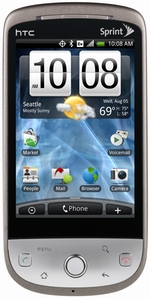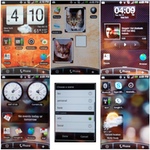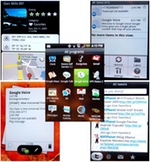By Lisa Phifer
November 05, 2009
There’s a lot to like about HTC’s Hero, but a few weaknesses keep it from claiming first place among Android-based phones.
Price: $179.99 after rebate, with 2-year plan
Pros: Personalized “scenes,” sexy multi-touch UI, integrated messaging/contacts, extensible
Cons: Size-limited virtual keyboard, not-so-speedy Wi-Fi, can’t yet run latest Android
The much-anticipated HTC Hero is a top contender in today’s exploding touchscreen smartphone line-up. At Sprint, the HTC Hero is now battling the Samsung Moment for Android supremacy, advancing this open source platform from “nice try” to “impressive reality.”

With its readily personalized “scenes,” vibrant multi-touch screen, clean lines, and ability to simplify all forms of communication, the Hero makes an excellent first impression. Dig deeper and you’ll find more to love – along with key limitations that prevent the Hero from taking first place in the Android arena.
Going Google – And More
Like other Android smartphones, the Hero delivers ready access to Google mobile services, including Google Search, Google Maps, Gmail, and Google Voice. Likewise, the Hero sports Android extensibility features like easily-added widgets and apps downloaded from the Android Marketplace. Although the Marketplace is still an order of magnitude smaller than Apple’s App Store, Android’s open approach and handset sales should spur rapid expansion.But the Hero goes well beyond this Android/Google foundation. This smartphone’s appeal starts with its clean, compact body. At 4.4″ x 2.2″ x 0.54″ and 4.5 ounces, it is smaller and lighter than the Moment or iPhone 3GS. Pre-release Heroes exhibited an angular “chin” that has since disappeared, leaving a smooth, nearly button-free face and tiny-pearl trackball.
Beneath this sleek exterior lies a Qualcomm MSM7200A 528 MHz CPU, 3.2″ HVGA TFT capacitive multi-touch screen, 5MP camera/camcorder, accelerometer, light sensor, GPS, 512 MB ROM, 288 MB RAM, 2 GB (max 32) microSD card, and removable 1500 mAh battery. Sprint’s Hero combines 802.11b/g and Bluetooth 2.0+EDR radios with EV-DO Rev. A mobile voice and data. A GSM version is sold elsewhere (e.g., Telus in Canada).
The Hero’s only big physical shortfall (versus the Moment or Verizon DROID) is its lack of a QWERTY keyboard. HTC improved upon Android’s standard virtual keyboard, but there just isn’t enough real-estate here to type fast.
To HTC’s credit, the Hero’s V-keyboard auto-rotates and confirms input with vibrate and zoom-char feedback. But even after calibration, weeks of practice, and resorting to HTC’s two-chars-per-key compact layout, our “fat finger” typos occurred with annoying frequency.
Making Hero Your Own
Of course, many finger-friendly phone keyboards are paired with rigid, hard-to-navigate screens. Not the Hero. This baby excels at personalization through HTC Scenes: easily-swapped profiles that control widget, app, and data object layout and home/lock screen appearance. Even newbies can create their own custom Scene in under a minute by selecting a layout, dragging unwanted elements to the trash, and then adding shortcuts, HTC/Android widgets, and folders.

You can create and save as many Scenes as you wish and quickly switch between them. We created our own personal, business, and on-the-road Scenes (below) by adding shortcuts to programs, bookmarks, playlists, mailboxes, and contact list entries. Oft-referenced objects like clocks, weather, appointments, messages, people, and photos can also be reached directly using standard Android or Hero-optimized HTC widgets. All Scene components can be dragged anywhere on the home page or three “flickable” side-panels.
HTC Scenes thus make it trivial to forge uncluttered panels composed of only the shortcuts and data needed at any given moment. Our only beef: We’d love to associate volume with Scenes – for example, we couldn’t create a meeting Scene that defaulted to silent.
All Together Now
The Hero doesn’t synergize cloud data as extensively as the Palm Pre. Instead, the Hero focuses on unifying communication vectors and automating access to underlying services.
For example, the Hero can auto-log you into three social networks: Twitter, Facebook, and Flickr. But a single Photos app displays all of your pix, whether snapped with the Hero’s camera, stored on SD, or posted on Flickr. Similarly, the Hero’s unified IM app lets you chat seamlessly with Google, AIM, Windows Live Messenger, and Yahoo! users.
Related Articles
- Storm2 with Wi-Fi Arrives Amid Positive Reviews
- Verizon’s New Droid Ads Call Out iPhone
- Opinion: Smartphones Require Smart Handling in the Enterprise
- Review: iPhone 3G (AT&T;)
The “People” app merges contacts synchronized from Exchange, Google, PC Outlook, and Facebook. But the outcome isn’t always perfect – we ended up with a few duplicates. On the plus side, every contact displays a count of recent communication with that person. With one click, you can list e-mails from that contact, IMs from that contact, past calls from that contact, or go right to their Facebook or Flickr pages.
An HTC widget delivers ready access to any POP/IMAP, Outlook, or Exchange mailbox. For example, we added an Exchange widget to our business Scene and a POP widget to our personal Scene. Unified access to all of your mailboxes can also be obtained through the Hero’s Mail client. In addition to the usual sorted lists, tabs can display “conversations” (threads) and flagged messages. Business users will appreciate Microsoft Exchange Direct Push support and Exchange/Outlook calendar synchronization.
The Hero further simplifies communication with native support for common data formats. PDF and QuickOffice readers are built-in; we had no trouble viewing Word, Excel, and Powerpoint attachments. URLs carried by any message launch the Hero’s browser. Flash and JavaScript support. auto-rotation, pinch-to-zoom, and gesture navigation all aid usability, but the Hero’s size still cripples some websites.
Made-to-order Apps
In addition to the camera, music, Google, social network, and messaging apps, the Hero ships with half a dozen unique apps authored by HTC and Sprint.

For example, you can browse the Twitter website, download your favorite Twitter client from the Marketplace, or use HTC’s own Twitter client (below, right). This client is optimized to trigger home page notifications and fit tweets to the Hero’s screen; we hope the next release will refresh a bit faster.
HTC fared better with the Hero’s uniquely friendly Footprints app (below, left). To use Footprints, just snap a photo of a place you’ve visited (e.g., restaurant, hotel, office); the Hero adds GPS coordinates. Whenever you want to return, Footprints can help you recall, map, and even navigate to each saved venue.
We expanded the Hero’s default Google apps by downloading GoogleVoice. Once installed, GoogleVoice dove-tailed with other standard Hero apps. For example, the Hero’s dialer let us choose whether to place calls using GoogleVoice or Sprint, and we could view/play voicemail messages through GoogleVoice itself or any mailbox.
Some Sprint apps are bundled with every smartphone the carrier sells, including the Hero. We loved Sprint’s Navigation and would gladly pay the monthly subscription fee. We also enjoyed the SprintTV viewer, which streams free and paid video and Internet radio. Alas, SprintTV only works on Sprint’s mobile broadband network – those megabytes can’t be offloaded to Wi-Fi. Native Sprint NFL Mobile Live and Nascar Sprint Cup apps round out the pack.
Our only complaint about these factory-installed apps is that they cannot be removed. Settings can be used to view active programs, RAM consumption, and uninstall downloaded apps – but not ROM apps. If you’re not a sports fan, those apps just consume precious memory. If you’d rather listen to MP3’s from Amazon or watch YouTube, more KBs go to waste.
Why complain? After all, unlike the iPhone or Palm Pre, the Hero’s 2 GB microSD can be upgraded to 32 GB. Unfortunately, apps can only be downloaded to main memory. That microSD only provides plentiful storage for data (e.g., music, photos, videos, attachments), not apps. But kudos to HTC for making microSD files readily accessible using an ordinary USB cable.
Wireless Mobility
Ultimately, these cool Hero apps wouldn’t be useful without wireless connectivity. The spec sheet advertises a competitive set of interfaces, so we dug deeper to uncover the Hero’s wireless strengths and weaknesses.
We got OK throughput over 3G (EV-DO), as measured by the Xtremelabs Speedtest app for Android. In theory, the Hero can reach speeds up to 2 Mbps (up) and 7.2 Mbps (down). Our best throughput (sampled over two weeks and 300 miles) was 427.7 Kbps (up) and 1.355 Mbps (down). At the time, Sprint’s website reported that Hero Settings read “CDMA – EV-DO Rev. 0” even when the device was operating on Rev A., so we cannot confirm our measurements were taken over Rev. A. We can, however, say that SprintTV video and radio streams were delivered smoothly in EV-DO coverage areas.
We were pleased to find that Sprint’s Hero can be used as a tethered 3G modem – so long as it is physically connected via USB to the computer that needs connectivity. To enable tethering, just check the Wireless Settings Mobile Network Sharing box.
Like many smartphones, the Hero’s Bluetooth 2.0+EDR radio supports just four profiles: Headset, Handsfree, Advanced Audio Distribution Profile, and Audio/Video Control Transport Protocol. We easily paired our Hero with an Acura TL sound system, a Motorola Bluetooth headset, and a Dell E6400 laptop. However, we could only use the latter to listen to music through laptop speakers. Without additional profiles, we couldn’t transfer files or use the Hero as a tethered modem over Bluetooth (as we could over USB)
Wi-Fi Is a Mixed Bag
With Wi-Fi, the Hero starts off strong, but then – frankly, we were a bit disappointed. Like most smartphones, the Hero can notify when WLANs are available. Just pull down on the home screen notification to view a list of SSIDs (below), choose the desired WLAN, and off you go.
Hero Wi-Fi, Click to Enlarge
If the WLAN is unsecured, the Hero tries to associate and remembers the SSID. If the WLAN uses WEP, WPA-PSK, or WPA2-PSK, it first prompts for a key (again, saved for future use). But when the WLAN uses WPA/WPA2-802.1X, things get a bit more complicated.
The Hero’s 802.1X supplicant supports EAP-TLS, PEAPv0, PEAPv1, and EAP-TTLS. However, we only used PEAPv0 successfully. Despite a Security Certificates panel, we could not add a client certificate for EAP-TLS or a server certificate for any EAP. As the most common EAP, PEAPv0 is a good start, but we’d like to see more – or at least better 802.1X documentation.Once associated to any WLAN, the Hero displays status, speed, channel, signal strength, and leased IP address. If the connection is lost, the Hero tries to auto-reconnect to any SSID used in the past. So far, so good. But we could not see any way to prioritize SSIDs or require manual connection (short of deleting past SSIDs).
Fortunately, the Hero offers more control over Wi-Fi/3G roaming. A Sleep Policy determines whether Wi-Fi is disabled when the Hero’s screen blanks, when it is plugged into a power source, or never. The Hero always prefers Wi-Fi where available, reverting to 3G whenever Wi-Fi is lost. Thus, if your Wi-Fi radio turns off when the screen blanks, the Hero roams to 3G. If you want to keep the Hero on Wi-Fi longer, change your Sleep Policy.
The Hero does not officially support Ad Hoc mode, but this can be accomplished by first “rooting” the phone and then editing Wi-Fi config files manually or using Android-Wifi-Tether. We did not have root access to our demo unit, so did not try this. However, the next release of Android (not yet available for the Hero) will support not only Ad Hoc mode, but also PPTP, L2TP, and IPsec VPNs.
Aside from EAP-TLS, we had no trouble associating to more than half a dozen 802.11g and 802.11n APs of different makes and security settings. Our Hero routinely connected at the top 802.11g rate of 54 Mbps, sticking to that rate at reasonable distances. However, when we tried to measure Wi-Fi throughput, we ran into a snag.
Throughput measured using local file transfer varied by client and direction. The Greyhound FTP client consistently averaged 6.4 Mbps (down) and 5.12 Mbps (up), while AndFTP averaged 2.88 Mbps (down) and 1.44 Mbps (up) – same files, same server, same dedicated AP. Either way, these numbers fall far short of most 802.11g clients.
As a sanity check, we ran Xtremelabs tests over Wi-Fi, through broadband, averaging 3.5 Mbps (down) and 1 Mbps (up). Similar speed tests on a Wi-Fi laptop yielded 5x that throughput, suggesting that Hero tests were not constrained by our broadband link. In the absence of better test tools for Android, we can only conclude that today’s Hero apps are more capable of 3G/802.11b-like throughputs than 802.11g.
The Bottom Line
After a few weeks with the Hero, we were sorry to see it head back to Sprint. The Hero’s Wi-Fi slowness bothered us less than its touchy virtual keyboard – perhaps with more time we’d master that. But given several smartphones at our disposal, we found ourselves choosing the Hero to check e-mail and IMs and to stay entertained and informed on road trips. Ultimately, the Hero was a reliable, easy-to-use on-the-go communicator that adapted to us like no other smartphone has.
- A Fortress at Home: Top Strategies to Bulletproof Your Home Network - June 24, 2024
- Wired vs Wireless Connection: Which is Better for Gaming - May 28, 2024
- How to Protect Your Wi-Fi Connection - May 3, 2024